MAE101 Economic Principles: Trade, Tariffs and Policy - Deakin
VerifiedAdded on 2023/06/12
|9
|1170
|459
Report
AI Summary
This report provides a comprehensive analysis of trade and tariffs, focusing on key economic principles. It defines absolute and comparative advantage, discusses opportunity costs with a dentist example, and analyzes market dynamics under free trade and with tariff imposition. The report examines the effects of trade policies on consumer and producer surplus, considers arguments for trade restrictions to protect infant industries, and addresses the issue of dumping. Furthermore, it explores the broader policy implications of import tariffs, including their impact on import volumes and domestic production. The benefits of free trade, such as increased competition and efficient resource allocation, are also highlighted. The analysis uses diagrams to illustrate the effects of trade policies on prices, quantities, and welfare. This resource is available on Desklib, which offers a range of study tools including past papers and solved assignments.
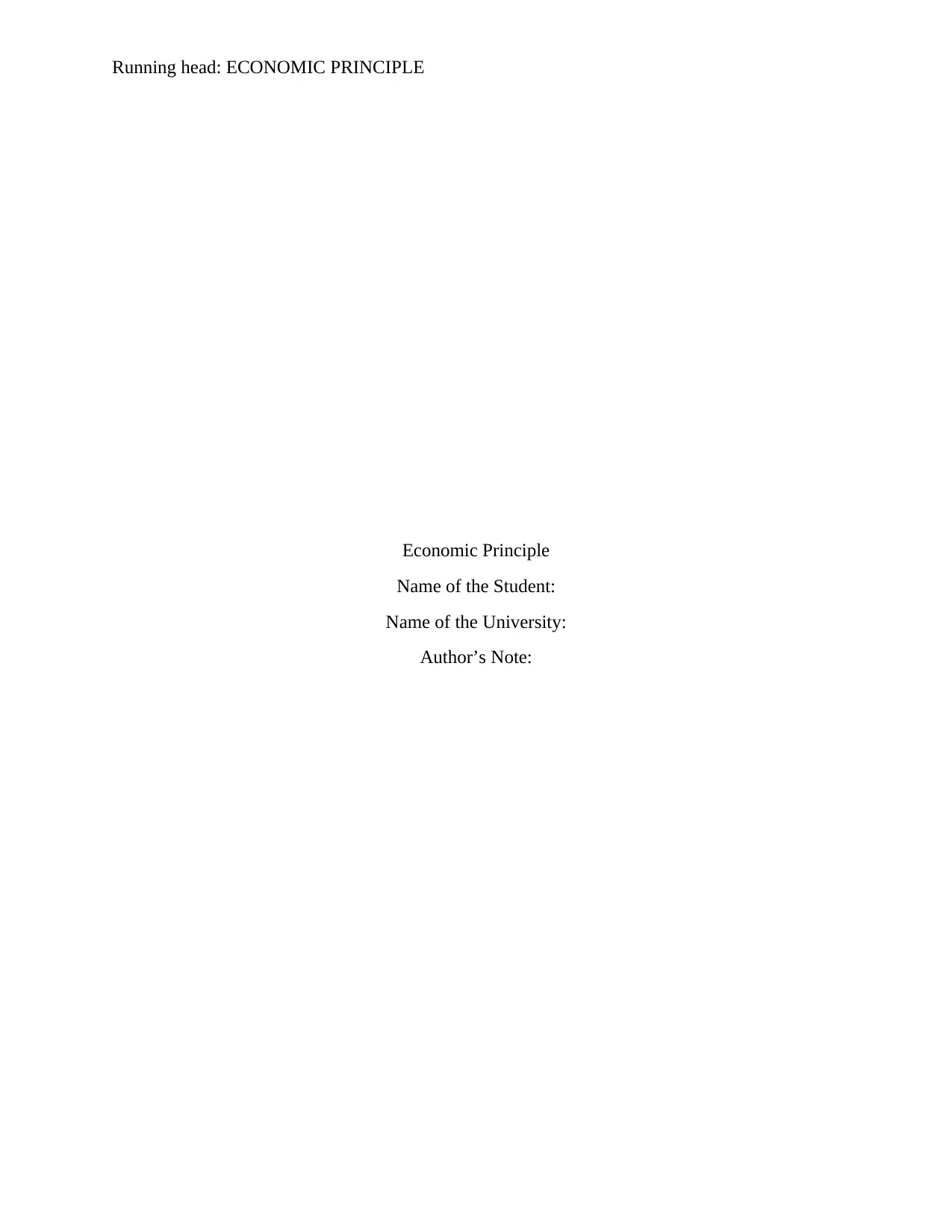
Running head: ECONOMIC PRINCIPLE
Economic Principle
Name of the Student:
Name of the University:
Author’s Note:
Economic Principle
Name of the Student:
Name of the University:
Author’s Note:
Paraphrase This Document
Need a fresh take? Get an instant paraphrase of this document with our AI Paraphraser
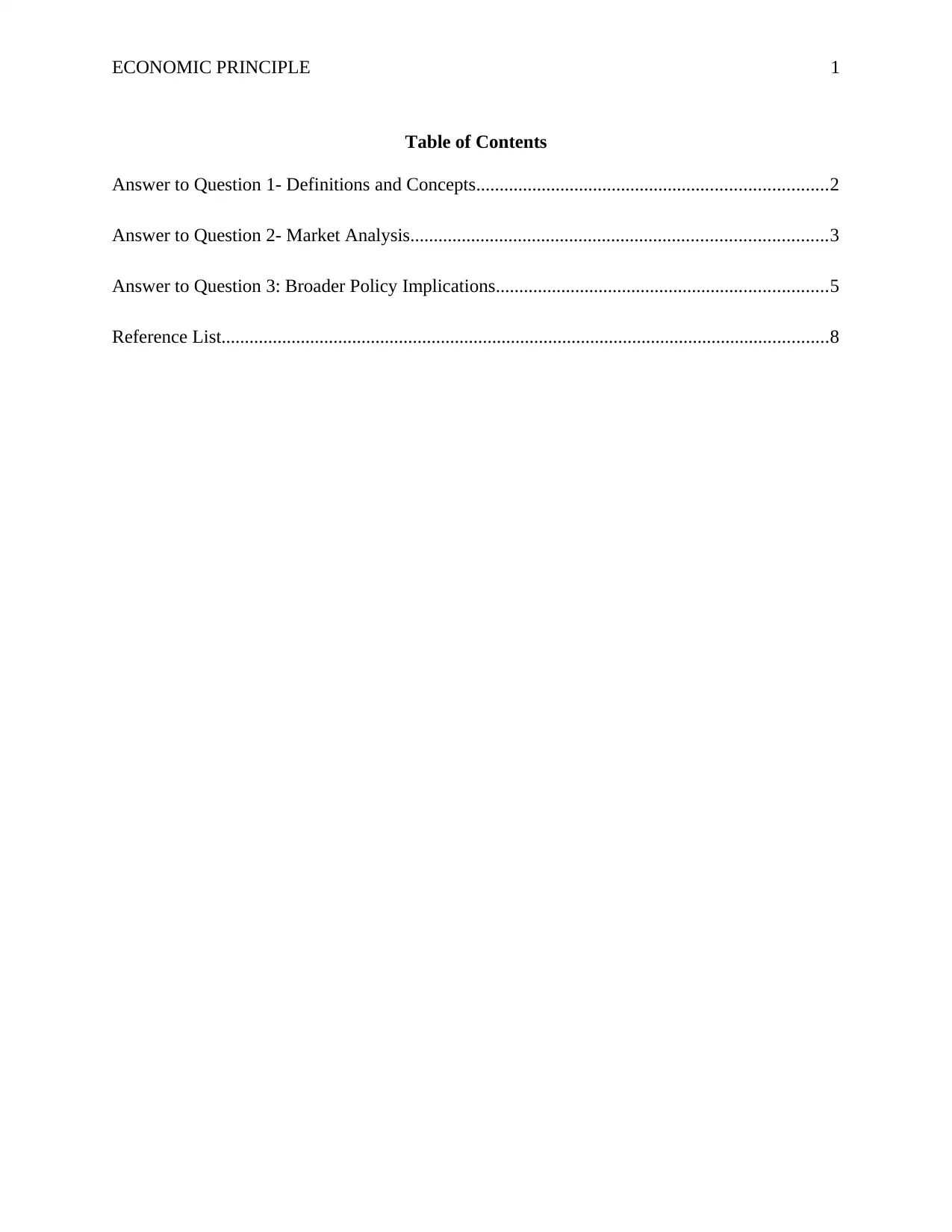
ECONOMIC PRINCIPLE 1
Table of Contents
Answer to Question 1- Definitions and Concepts...........................................................................2
Answer to Question 2- Market Analysis.........................................................................................3
Answer to Question 3: Broader Policy Implications.......................................................................5
Reference List..................................................................................................................................8
Table of Contents
Answer to Question 1- Definitions and Concepts...........................................................................2
Answer to Question 2- Market Analysis.........................................................................................3
Answer to Question 3: Broader Policy Implications.......................................................................5
Reference List..................................................................................................................................8
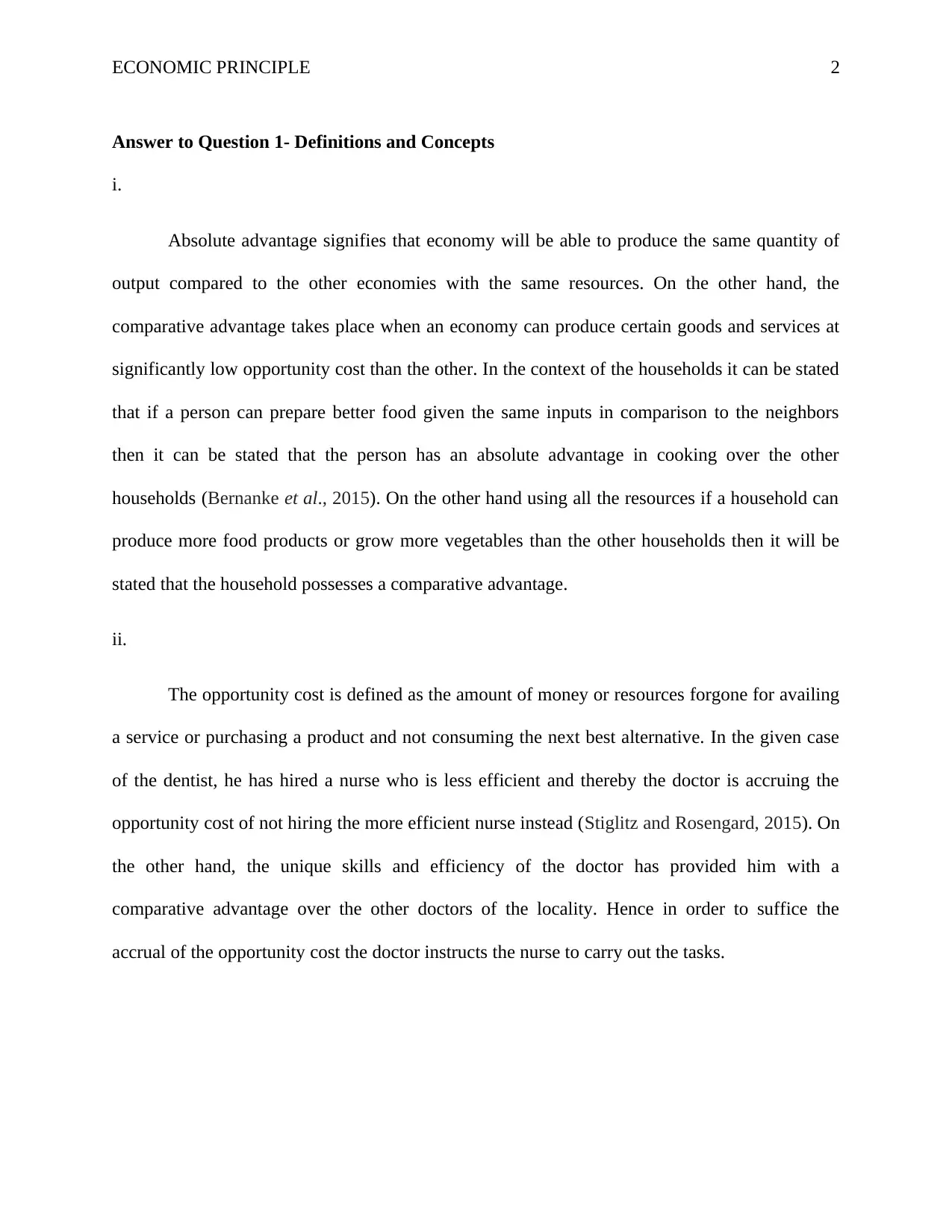
ECONOMIC PRINCIPLE 2
Answer to Question 1- Definitions and Concepts
i.
Absolute advantage signifies that economy will be able to produce the same quantity of
output compared to the other economies with the same resources. On the other hand, the
comparative advantage takes place when an economy can produce certain goods and services at
significantly low opportunity cost than the other. In the context of the households it can be stated
that if a person can prepare better food given the same inputs in comparison to the neighbors
then it can be stated that the person has an absolute advantage in cooking over the other
households (Bernanke et al., 2015). On the other hand using all the resources if a household can
produce more food products or grow more vegetables than the other households then it will be
stated that the household possesses a comparative advantage.
ii.
The opportunity cost is defined as the amount of money or resources forgone for availing
a service or purchasing a product and not consuming the next best alternative. In the given case
of the dentist, he has hired a nurse who is less efficient and thereby the doctor is accruing the
opportunity cost of not hiring the more efficient nurse instead (Stiglitz and Rosengard, 2015). On
the other hand, the unique skills and efficiency of the doctor has provided him with a
comparative advantage over the other doctors of the locality. Hence in order to suffice the
accrual of the opportunity cost the doctor instructs the nurse to carry out the tasks.
Answer to Question 1- Definitions and Concepts
i.
Absolute advantage signifies that economy will be able to produce the same quantity of
output compared to the other economies with the same resources. On the other hand, the
comparative advantage takes place when an economy can produce certain goods and services at
significantly low opportunity cost than the other. In the context of the households it can be stated
that if a person can prepare better food given the same inputs in comparison to the neighbors
then it can be stated that the person has an absolute advantage in cooking over the other
households (Bernanke et al., 2015). On the other hand using all the resources if a household can
produce more food products or grow more vegetables than the other households then it will be
stated that the household possesses a comparative advantage.
ii.
The opportunity cost is defined as the amount of money or resources forgone for availing
a service or purchasing a product and not consuming the next best alternative. In the given case
of the dentist, he has hired a nurse who is less efficient and thereby the doctor is accruing the
opportunity cost of not hiring the more efficient nurse instead (Stiglitz and Rosengard, 2015). On
the other hand, the unique skills and efficiency of the doctor has provided him with a
comparative advantage over the other doctors of the locality. Hence in order to suffice the
accrual of the opportunity cost the doctor instructs the nurse to carry out the tasks.
⊘ This is a preview!⊘
Do you want full access?
Subscribe today to unlock all pages.

Trusted by 1+ million students worldwide
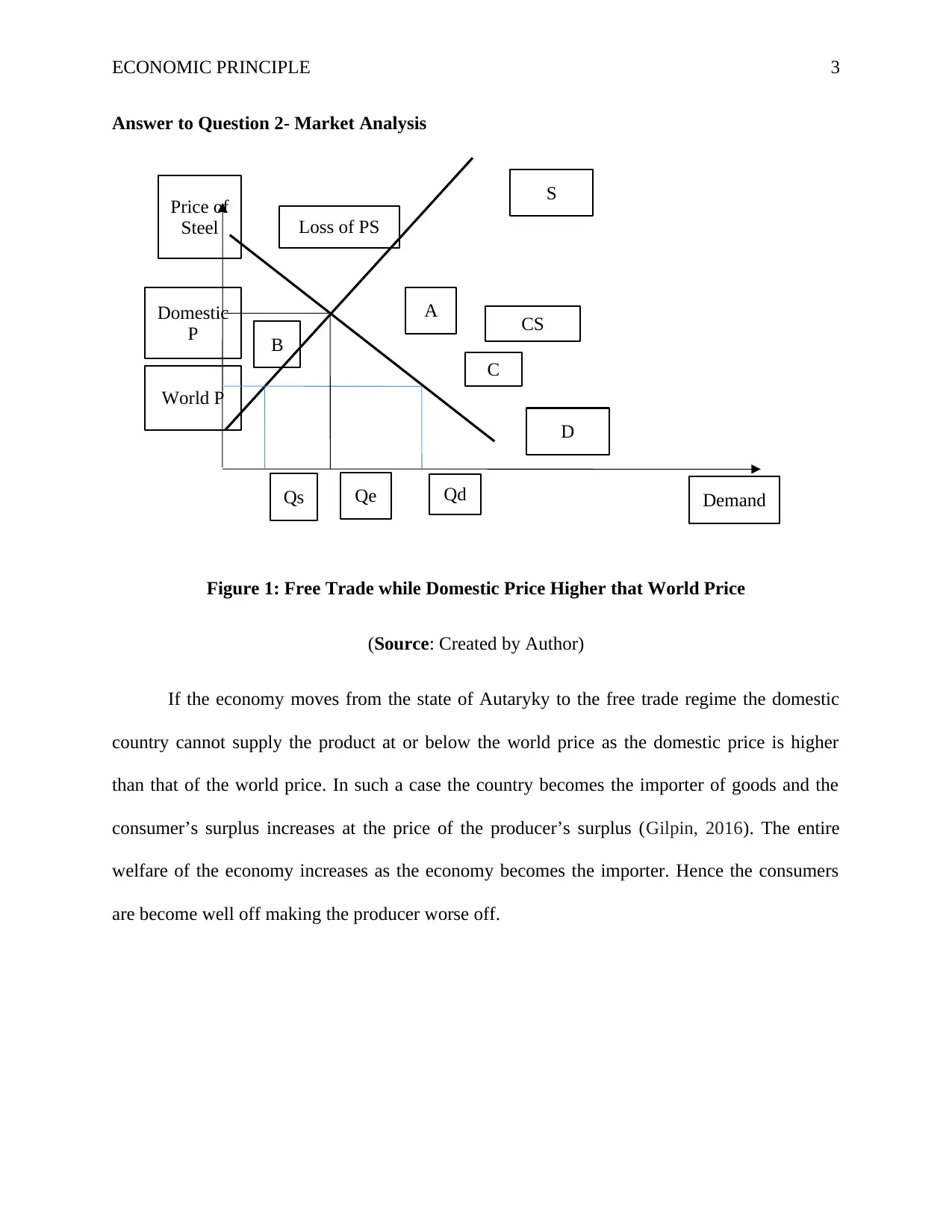
S
Price of
Steel
Domestic
P
World P
Qs Qe Qd Demand
D
A
C
B
Loss of PS
CS
ECONOMIC PRINCIPLE 3
Answer to Question 2- Market Analysis
Figure 1: Free Trade while Domestic Price Higher that World Price
(Source: Created by Author)
If the economy moves from the state of Autaryky to the free trade regime the domestic
country cannot supply the product at or below the world price as the domestic price is higher
than that of the world price. In such a case the country becomes the importer of goods and the
consumer’s surplus increases at the price of the producer’s surplus (Gilpin, 2016). The entire
welfare of the economy increases as the economy becomes the importer. Hence the consumers
are become well off making the producer worse off.
Price of
Steel
Domestic
P
World P
Qs Qe Qd Demand
D
A
C
B
Loss of PS
CS
ECONOMIC PRINCIPLE 3
Answer to Question 2- Market Analysis
Figure 1: Free Trade while Domestic Price Higher that World Price
(Source: Created by Author)
If the economy moves from the state of Autaryky to the free trade regime the domestic
country cannot supply the product at or below the world price as the domestic price is higher
than that of the world price. In such a case the country becomes the importer of goods and the
consumer’s surplus increases at the price of the producer’s surplus (Gilpin, 2016). The entire
welfare of the economy increases as the economy becomes the importer. Hence the consumers
are become well off making the producer worse off.
Paraphrase This Document
Need a fresh take? Get an instant paraphrase of this document with our AI Paraphraser
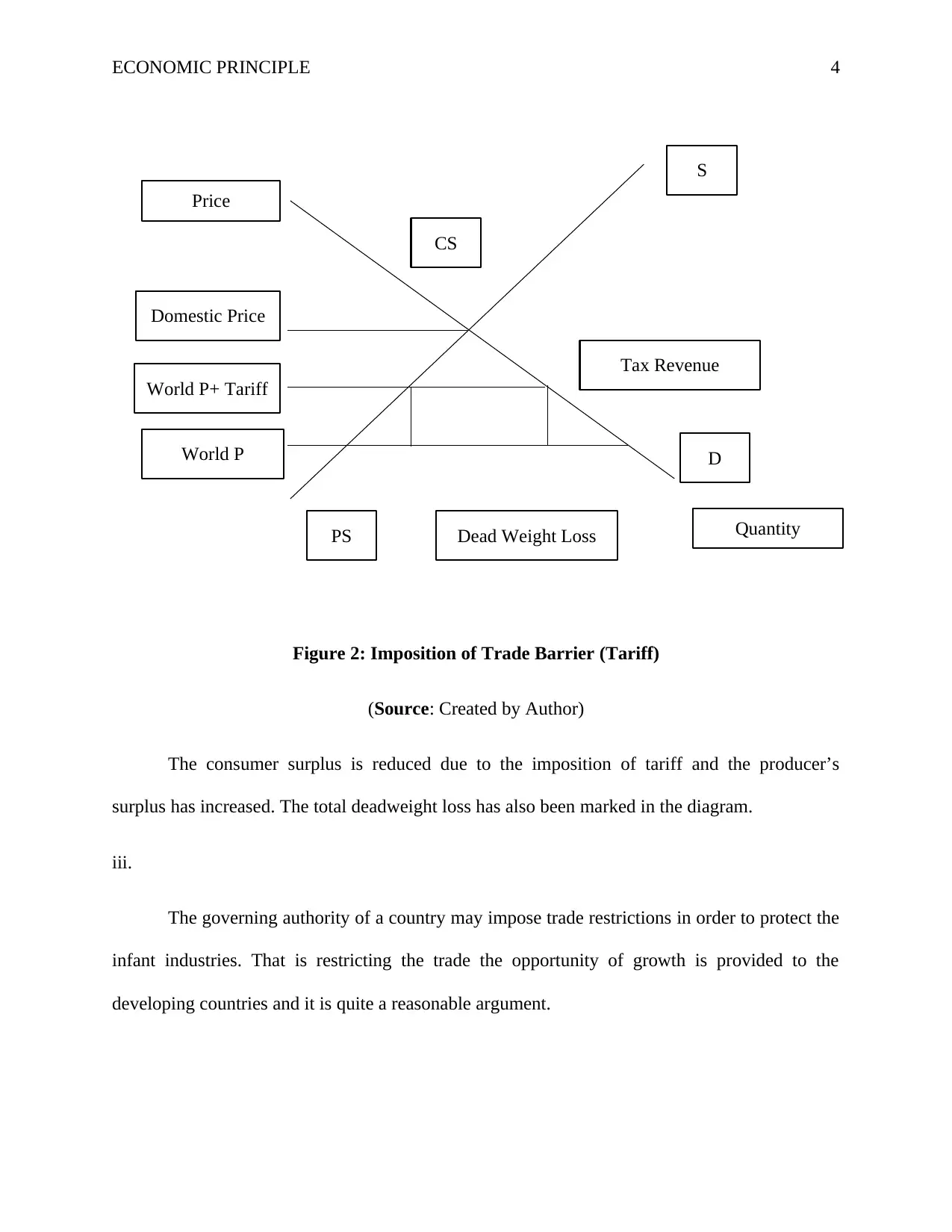
Price
S
CS
Domestic Price
World P+ Tariff
World P
Dead Weight LossPS
Tax Revenue
D
Quantity
ECONOMIC PRINCIPLE 4
Figure 2: Imposition of Trade Barrier (Tariff)
(Source: Created by Author)
The consumer surplus is reduced due to the imposition of tariff and the producer’s
surplus has increased. The total deadweight loss has also been marked in the diagram.
iii.
The governing authority of a country may impose trade restrictions in order to protect the
infant industries. That is restricting the trade the opportunity of growth is provided to the
developing countries and it is quite a reasonable argument.
S
CS
Domestic Price
World P+ Tariff
World P
Dead Weight LossPS
Tax Revenue
D
Quantity
ECONOMIC PRINCIPLE 4
Figure 2: Imposition of Trade Barrier (Tariff)
(Source: Created by Author)
The consumer surplus is reduced due to the imposition of tariff and the producer’s
surplus has increased. The total deadweight loss has also been marked in the diagram.
iii.
The governing authority of a country may impose trade restrictions in order to protect the
infant industries. That is restricting the trade the opportunity of growth is provided to the
developing countries and it is quite a reasonable argument.
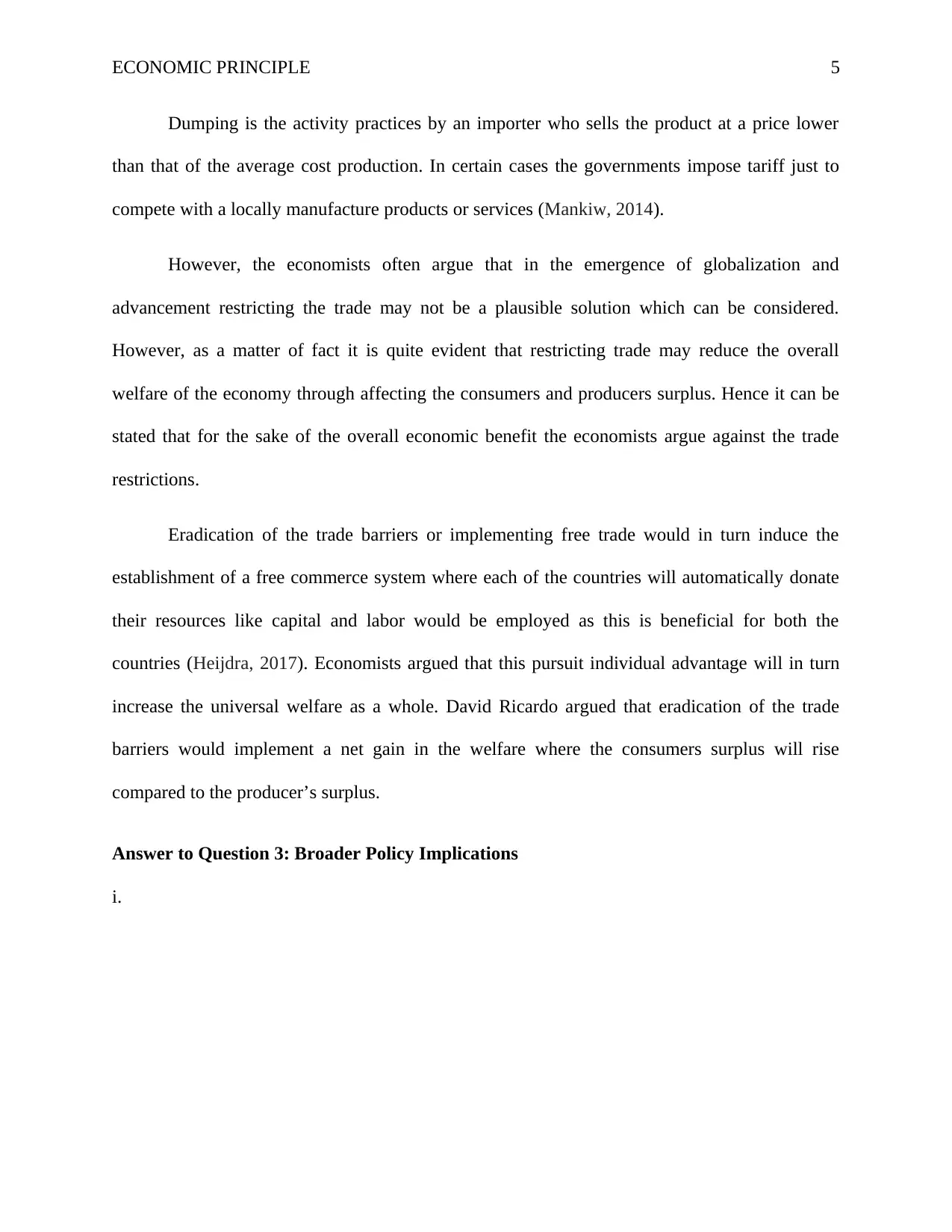
ECONOMIC PRINCIPLE 5
Dumping is the activity practices by an importer who sells the product at a price lower
than that of the average cost production. In certain cases the governments impose tariff just to
compete with a locally manufacture products or services (Mankiw, 2014).
However, the economists often argue that in the emergence of globalization and
advancement restricting the trade may not be a plausible solution which can be considered.
However, as a matter of fact it is quite evident that restricting trade may reduce the overall
welfare of the economy through affecting the consumers and producers surplus. Hence it can be
stated that for the sake of the overall economic benefit the economists argue against the trade
restrictions.
Eradication of the trade barriers or implementing free trade would in turn induce the
establishment of a free commerce system where each of the countries will automatically donate
their resources like capital and labor would be employed as this is beneficial for both the
countries (Heijdra, 2017). Economists argued that this pursuit individual advantage will in turn
increase the universal welfare as a whole. David Ricardo argued that eradication of the trade
barriers would implement a net gain in the welfare where the consumers surplus will rise
compared to the producer’s surplus.
Answer to Question 3: Broader Policy Implications
i.
Dumping is the activity practices by an importer who sells the product at a price lower
than that of the average cost production. In certain cases the governments impose tariff just to
compete with a locally manufacture products or services (Mankiw, 2014).
However, the economists often argue that in the emergence of globalization and
advancement restricting the trade may not be a plausible solution which can be considered.
However, as a matter of fact it is quite evident that restricting trade may reduce the overall
welfare of the economy through affecting the consumers and producers surplus. Hence it can be
stated that for the sake of the overall economic benefit the economists argue against the trade
restrictions.
Eradication of the trade barriers or implementing free trade would in turn induce the
establishment of a free commerce system where each of the countries will automatically donate
their resources like capital and labor would be employed as this is beneficial for both the
countries (Heijdra, 2017). Economists argued that this pursuit individual advantage will in turn
increase the universal welfare as a whole. David Ricardo argued that eradication of the trade
barriers would implement a net gain in the welfare where the consumers surplus will rise
compared to the producer’s surplus.
Answer to Question 3: Broader Policy Implications
i.
⊘ This is a preview!⊘
Do you want full access?
Subscribe today to unlock all pages.

Trusted by 1+ million students worldwide
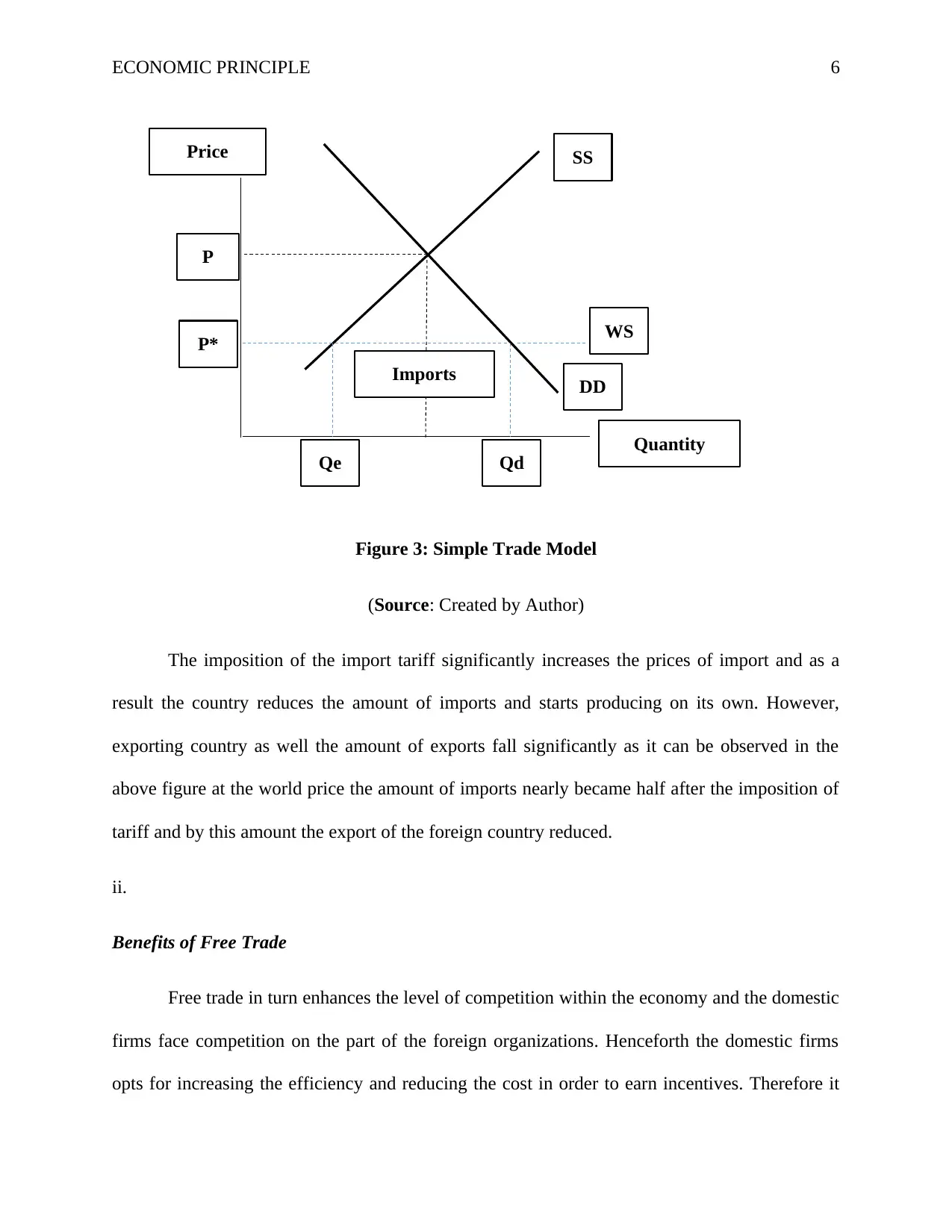
SSPrice
Imports
WS
P
P*
Qe Qd
Quantity
DD
ECONOMIC PRINCIPLE 6
Figure 3: Simple Trade Model
(Source: Created by Author)
The imposition of the import tariff significantly increases the prices of import and as a
result the country reduces the amount of imports and starts producing on its own. However,
exporting country as well the amount of exports fall significantly as it can be observed in the
above figure at the world price the amount of imports nearly became half after the imposition of
tariff and by this amount the export of the foreign country reduced.
ii.
Benefits of Free Trade
Free trade in turn enhances the level of competition within the economy and the domestic
firms face competition on the part of the foreign organizations. Henceforth the domestic firms
opts for increasing the efficiency and reducing the cost in order to earn incentives. Therefore it
Imports
WS
P
P*
Qe Qd
Quantity
DD
ECONOMIC PRINCIPLE 6
Figure 3: Simple Trade Model
(Source: Created by Author)
The imposition of the import tariff significantly increases the prices of import and as a
result the country reduces the amount of imports and starts producing on its own. However,
exporting country as well the amount of exports fall significantly as it can be observed in the
above figure at the world price the amount of imports nearly became half after the imposition of
tariff and by this amount the export of the foreign country reduced.
ii.
Benefits of Free Trade
Free trade in turn enhances the level of competition within the economy and the domestic
firms face competition on the part of the foreign organizations. Henceforth the domestic firms
opts for increasing the efficiency and reducing the cost in order to earn incentives. Therefore it
Paraphrase This Document
Need a fresh take? Get an instant paraphrase of this document with our AI Paraphraser
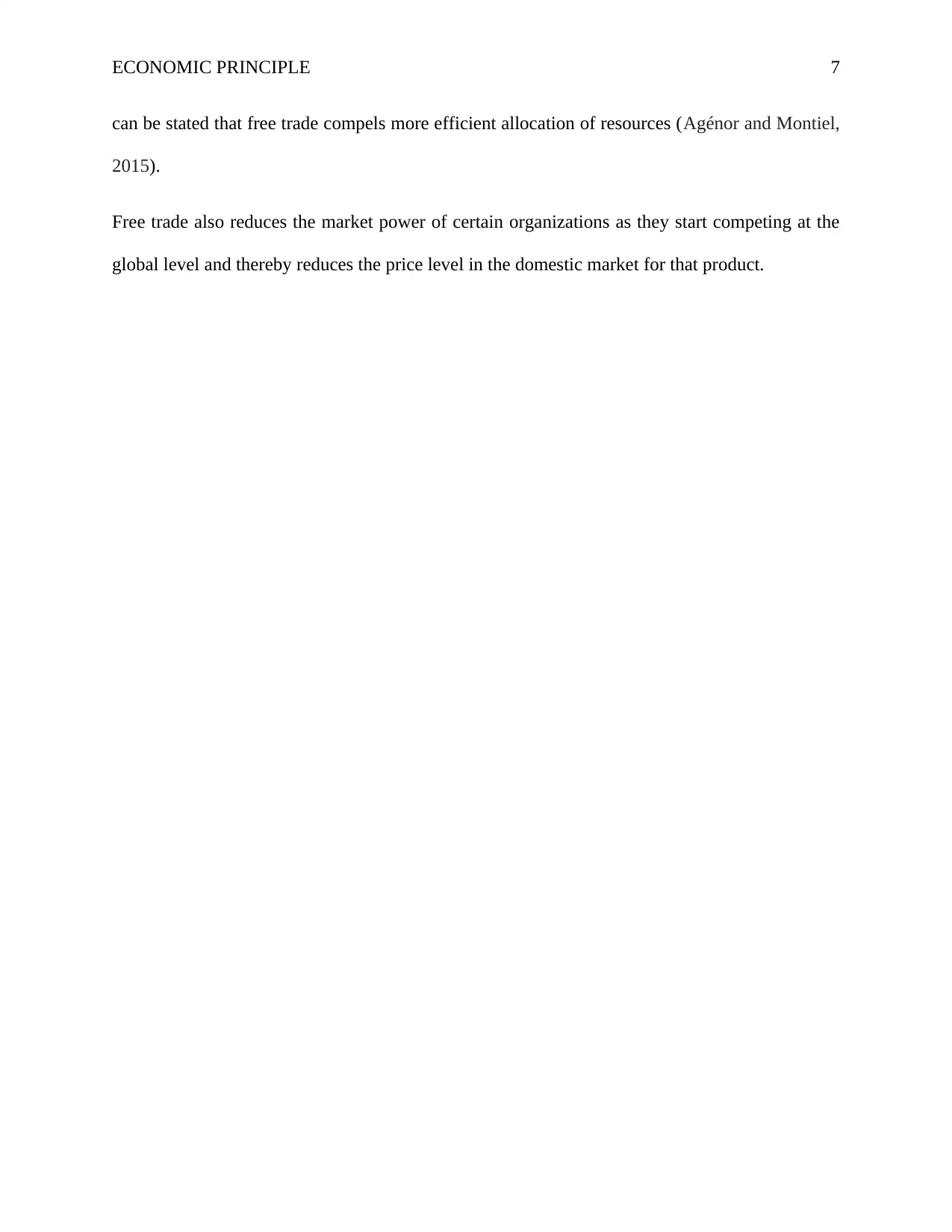
ECONOMIC PRINCIPLE 7
can be stated that free trade compels more efficient allocation of resources (Agénor and Montiel,
2015).
Free trade also reduces the market power of certain organizations as they start competing at the
global level and thereby reduces the price level in the domestic market for that product.
can be stated that free trade compels more efficient allocation of resources (Agénor and Montiel,
2015).
Free trade also reduces the market power of certain organizations as they start competing at the
global level and thereby reduces the price level in the domestic market for that product.

ECONOMIC PRINCIPLE 8
Reference List
Agénor, P.R. and Montiel, P.J., 2015. Development macroeconomics. Princeton University Press.
Bernanke, B., Antonovics, K. and Frank, R., 2015. Principles of macroeconomics. McGraw-Hill
Higher Education.
Gilpin, R., 2016. The political economy of international relations. Princeton University Press.
Heijdra, B.J., 2017. Foundations of modern macroeconomics. Oxford university press.
Mankiw, N.G., 2014. Principles of macroeconomics. Cengage Learning.
Stiglitz, J.E. and Rosengard, J.K., 2015. Economics of the Public Sector: Fourth International
Student Edition. WW Norton & Company.
Reference List
Agénor, P.R. and Montiel, P.J., 2015. Development macroeconomics. Princeton University Press.
Bernanke, B., Antonovics, K. and Frank, R., 2015. Principles of macroeconomics. McGraw-Hill
Higher Education.
Gilpin, R., 2016. The political economy of international relations. Princeton University Press.
Heijdra, B.J., 2017. Foundations of modern macroeconomics. Oxford university press.
Mankiw, N.G., 2014. Principles of macroeconomics. Cengage Learning.
Stiglitz, J.E. and Rosengard, J.K., 2015. Economics of the Public Sector: Fourth International
Student Edition. WW Norton & Company.
⊘ This is a preview!⊘
Do you want full access?
Subscribe today to unlock all pages.

Trusted by 1+ million students worldwide
1 out of 9
Related Documents
Your All-in-One AI-Powered Toolkit for Academic Success.
+13062052269
info@desklib.com
Available 24*7 on WhatsApp / Email
![[object Object]](/_next/static/media/star-bottom.7253800d.svg)
Unlock your academic potential
Copyright © 2020–2025 A2Z Services. All Rights Reserved. Developed and managed by ZUCOL.





